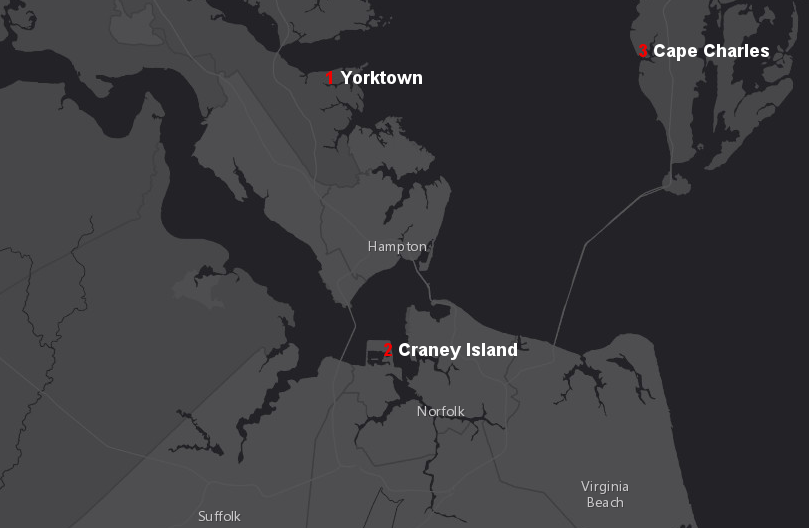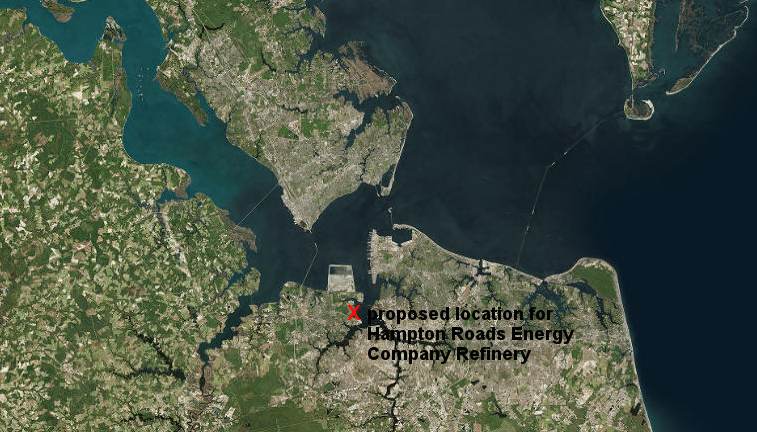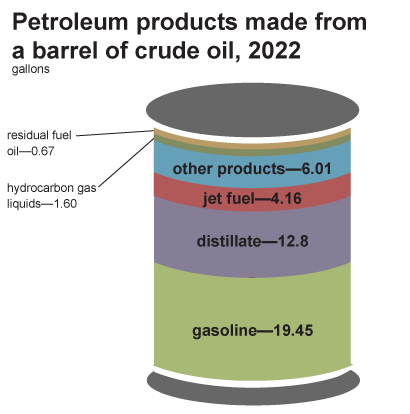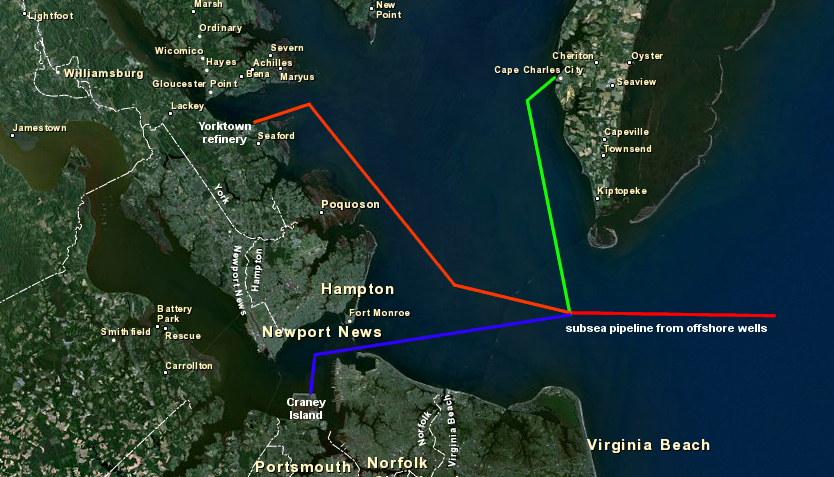
if a new oil refinery is built in Virginia, three potential locations are the old refinery site at Yorktown (1), the planned Craney Island Marine Terminal (2), or the Town of Cape Charles (3)
Source: ESRI, ArcGIS Online

if a new oil refinery is built in Virginia, three potential locations are the old refinery site at Yorktown (1), the planned Craney Island Marine Terminal (2), or the Town of Cape Charles (3)
Source: ESRI, ArcGIS Online
The last proposal for building a new oil refinery in Virginia centered on Hampton Roads.
In the mid-1970's, the 175,000-250,000 barrel/day Hampton Roads Energy Company Refinery was proposed at Portsmouth on the west bank of the Elizabeth River where the Virginia International Gateway (VIG) terminal is now located. Opposition to the environmental impacts, especially potential oil spills damaging oyster beds in the Elizabeth, Nansemond, and lower James River and wintering blue crabs in the lower Chesapeake Bay, delayed approval until changing business conditions killed the project.1
When the Corps or Engineers looked at alternatives to the proposed Hampton Roads Energy Company Refinery in the 1970's, it examined 67 sites and determined the best two were Portsmouth, Virginia and Eastport, Maine. Hampton Roads offers easy access for tankers to import crude oil, and for barges to carry refined products to various markets.
One challenge at Portsmouth: a new refinery in the urbanized area would add various "criteria pollutants" regulated by the Clean Air Act, including sulfur and nitrogen oxides - and carbon dioxide, of course. To facilitate construction of the refinery, the Virginia Department of Transportation proposed to revise its asphalt paving process for as far as 140 miles away in order to offset hydrocarbon emissions.12

the Virginia International Gateway (VIG) terminal was built on the site of the proposed Hampton Roads Energy Company Refinery, so that location is no longer available
Source: ESRI, ArcGIS Online
The next refinery proposal, if there is ever is one in Virginia, would also concentrate on building in Hampton Roads. Virginia produces only a minimal amount of crude oil in Lee County, not enough to justify the billion-dollar investment in a new refinery there.
Feedstock (crude oil) would have to be imported by tanker from foreign sources, or by pipeline from offshore platforms if oil is discovered under the Outer Continental Shelf. The most cost-effective location for a new refinery in Virginia would be near the tanker dock or the place where the underwater pipeline from offshore oil wells reaches land.
If hydrocarbons are discovered in economic quantities under the Outer Continental Shelf off the coast of Virginia, the Town of Cape Charles and York County might seek to build refineries. The man-made Craney Island Dredged Material Management Area, with no current structures and a deep shipping channel on the east side, could also be used if conflict with the Craney Island Marine Terminal could be avoided.
Expanding the remaining refineries on the Delaware River might be more competitive than building a new refinery in Virginia to process any oil produced from the Atlantic Coast Outer Continental Shelf. Those facilities are connected by an extensive pipeline network to customers in the New York area and western Pennsylvania/Ohio, and already have air and water quality permits.
When Sunoco planned to close its 330,000 barrel/day refinery in Philadelphia in 2012, the Environmental Protection Agency adjusted its interpretation of the Clean Air Act regulations. That allowed continued operation without forcing the facility to meet the tighter "new source review" standards. However, a series of damaging explosions at that facility one night in 2019 quickly led to the closure of the oldest and largest refinery on the East Coast.3
It is very unlikely that a new refinery to process crude oil will ever be constructed in Virginia. Demand for gasoline in the United States peaked in 2023, capped by the increase in fuel-efficient cars and the switch to electric vehicles.
Though no large refineries had been constructed in the United States since 1977, expansion of capacity at the 129 operable petroleum refineries remaining in 2023 had met the increased demand as the population had grown. The peak demand for diesel and jet fuel was predicted to come soon after 2023, as the United States decarbonized the transportation sector in response to climate change.4

refineries distill crude oil into different products
Source: US Energy Information Administration, Oil and petroleum products explained
Virginia may see construction of more small biodiesel refineries or ethanol plants. President George W. Bush visited the Virginia BioDiesel plant in West Point (Virginia) in 2005, and a major ethanol production facility finally opened in Hopewell in 2014.
Craney Island could become both a crude oil storage site (receiving Outer Continental Shelf oil from subsea pipelines and barging it to existing refineries on the Delaware River) and the site of a new ethanol plant/biodiesel refinery in Virginia. Various companies have proposed an ethanol plant/biodiesel refinery south of Jordan Bridge, on the border of Portsmouth and Chesapeake cities, but none have been built.5

oil from the Outer Continental Shelf could be barged to existing refineries on the Delaware River, or a new subsea pipeline could bring that oil to a new Virginia refinery
Source: US Fish and Wildlife Service, Wetlands Mapper